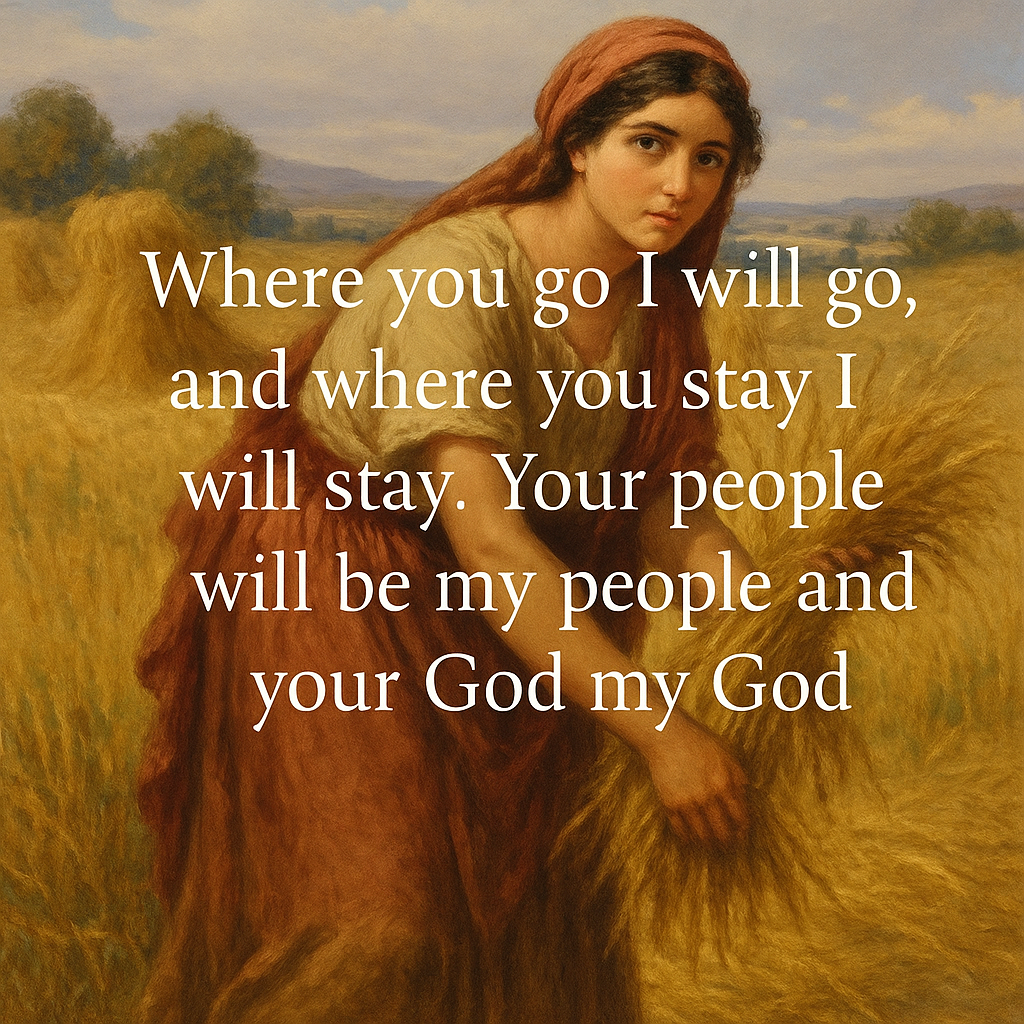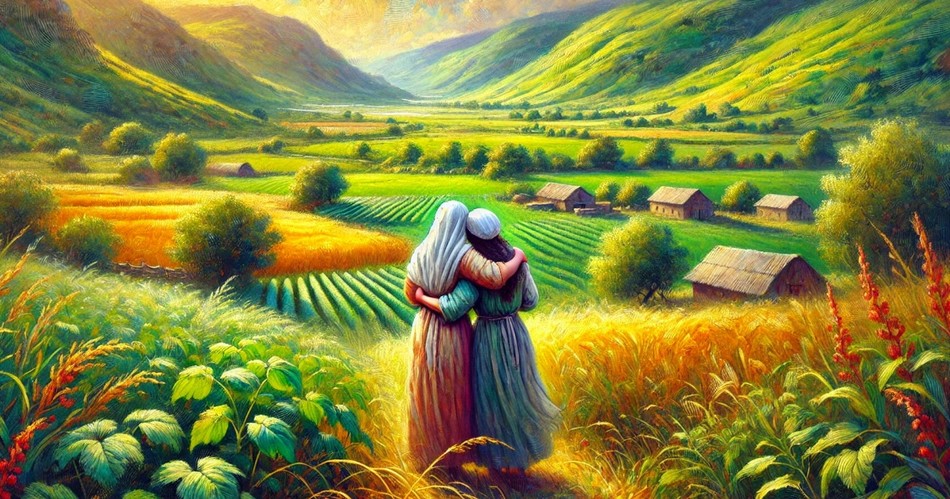God loves to take people who seem insignificant and do great things through them. The Bible is full of these stories. Abraham and Sarah were too old. David was forgotten. A boy only had a few fishes and loaves to feed thousands. Even Jesus came from a place with a bad reputation: “Can anything good come from Nazareth?” (John 1:46).
In reality, none of us is worthy or able to be used by God in ourselves. We’re under the curse of sin and death, selfish and stubborn, hopeless. These stories from the Bible reveal that all salvation is a work of God, from beginning to end. From rich to poor, great to small, only God’s grace redeems us and invites us into his grand story.
Ruth stands as a powerful example of God’s grace and redemption, taken from a cursed people to a mother of kings, and eventually the King of Kings.
Who Was Ruth in the Bible?
Ruth came from Moab. The Moabites descended from the incest between Lot and his daughter (Genesis 19:37). The Israelites considered the Moabites outsiders. When the Israelites traveled through the wilderness to the Promised Land, the Moabites resisted God’s people. They should have been welcoming and given assistance. Therefore, Moses declared the Moabites cursed—they couldn’t enter the gathering of God’s people for ten generations (Deuteronomy 23:3). Ruth came from a cursed people.
During a time of hardship, two Israelites from Judah (Elimelech and Naomi) moved to Moab for survival and economic reasons. Their sons, Mahlon and his brother, married Moabite women, Ruth and Orpah, despite the curse. However, Elimelech, Mahlon, and his brother died, leaving Naomi without her husband or sons, no one to care for her. In deep grief, Naomi decides to return to Bethlehem. Orpah and Ruth were also newly widowed, and Naomi encouraged them to stay. The women were young enough to remarry and have children, a future life.
After some protestation, Orpah leaves Naomi. But Ruth decides to return to Bethlehem with Naomi, treating her mother-in-law as her family.
The book of Ruth sets the stage. Ruth is a young widow from a cursed people, choosing a new land and people that might hate her, yet her commitment to Naomi and to Naomi's God shines through.
What Was Ruth’s Historical Context?
The surrounding regions also encountered change and chaos. In Egypt, the New Kingdom period ended, likely due to the traumatic events when God delivered Israel from their slavery. Pharaohs like Ramses III lost power, and Egypt lost influence or control over the city states in Canaan, leaving those people groups without a larger army to protect them against a force like Israel. The Assyrians and Babylonians existed but wouldn’t grow to any real power for centuries.
Moab was a small kingdom east of the Dead Sea. They had regular conflict with Israel’s tribes. Archaeology has confirmed Moab’s existence and interaction with Israel with things like the Mesha Slate, dated around 840 BC, after the time of Judges.
No extra-biblical records mention Ruth. Ancient sources almost never recorded the lives of ordinary people. She lived in a time of small, tribal kingdoms, and the Bible finds her story central to God’s redemptive story.
What Is the Biblical Context for Ruth?
Ruth lived during the time of the Judges, between 1200 and 1050 BC. This span of Israel’s history came after they conquered the land of Canaan, led by Joshua. Unfortunately, Israel failed to drive out all Canaanite nations as God commanded, which led to continued conflict over the next couple hundred years.
There were no kings. God was their king, and the Lord would raise up deliverers (called judges) when Israel needed saving from their own consequences or outside attack. The twelve tribes had trouble working together, often fighting amongst themselves. Judges 21:25 looks back at this time and summarizes with, “Everyone did what was right in his own eyes.”
The book of Judges reveals a pattern within Israel. After Joshua died, the people would regularly fall into sin and idolatry, and God would hand them over to other nations. Israel would cry out to the Lord, repent, and God would raise up a deliverer to save them from oppression.
Scripture doesn’t give a date for Ruth’s life, but most scholars put her between 1100 and 1050 BC, in relation to King David, her descendant. This would place her during judges like Ehud, Deborah, or maybe Gideon. Since Ruth’s story happens around a time of famine in Bethlehem, the best guess would be Ehud, when God would have disciplined Israel for their disobedience. However, Deborah would be an interesting possibility, another strong woman from the Bible.
After Ruth and Judges, Israel sinned and asked for a king, even though they already had the best one in God. The Lord let them have one, despite his warnings, and first chose Saul to be king. Through the next king, David, God even redeemed the Israelite disobedience in asking for a monarch. And Ruth was a part of that plan.
During the dark and tumultuous time of the Judges, we see God working toward the Messianic redemption through normal, broken people, a story of faithfulness and love during an age of chaos.
What Was Ruth’s Relationship with Naomi?
After the death of Naomi’s husband and sons, she decided to return to her homeland in Bethlehem. Naomi tried to tell Ruth to stay in Moab, but Ruth refused, saying, “Where you will go, I will go … Your people shall be my people, and your God my God” (Ruth 1:16).

According to the Mosaic Law, farmers were to leave the edges of their fields unharvested, and the poor could gather food and sustenance that way. Ruth took advantage of this provision, gleaning behind harvesters to provide for herself and Naomi. The young woman worked hard for Naomi’s welfare, but she also listened to the older widow’s wisdom, humbling herself and submitting to instruction when Boaz entered the picture.
Naomi changed her own name to Mara, which means “bitter.” Perhaps she felt judged by God for moving to the cursed land of Moab and felt that the deaths of her husband and sons were a consequence. And yet she returned to Bethlehem with a blessing in Ruth. Ruth’s love and faithfulness led to a redemptive marriage with Boaz, and Naomi found hope and new life with the son of Boaz and Ruth, Obed. The Bethlehem community says to Naomi about Ruth: “Your daughter in law, who loves you, is better to you than seven sons” (Ruth 4:15).
Ruth chose a relationship of covenant loyalty (in Hebrew, hesed), choosing to adopt Naomi’s family as her own family, even Naomi's God and people as her own. Through Ruth’s character, she became the great-grandmother of King David and in the lineage of the Messiah.
How Did Boaz Redeem Ruth?
Ruth chose to glean the leftovers in a rich man’s field. That man, Boaz, was noble and generous and happened to be from the same family as Elimelech, Naomi’s husband. Boaz recognized Ruth’s character. In Genesis, the Bible would often remark on a woman’s beauty—like Sarah, Rebekah, and others. But for Ruth, the Bible highlights her deep character as beautiful. She may have been physically pretty. However, as an older single man, Boaz would have understood the true value of a woman of love, hard work, self-sacrifice, and faithfulness.
Since Boaz was a close relative to Ruth’s deceased husband, he could act as a kinsman redeemer (go’el in Hebrew). According to custom and Mosaic Law, a redeemer had the right and even duty to marry a relative’s childless widow and have children with her to preserve a family line and land inheritance (Deuteronomy 25:5-10). As Boaz showed Naomi favor and attention, Naomi saw the possibilities of Boaz as a possible redeemer. Naomi told Ruth to be humble and respectful, appealing to Boaz’s care by lying at his feet at night. This cultural act asked for a person’s protection.
Boaz wanted to marry Ruth but knew another man was a closer relative. Boaz met with the men at the city gate, where legal and community matters would be resolved, and he offered Ruth’s redemption to the closer relative. The other man refused, afraid it might threaten his own land inheritance. Boaz claimed the right to redeem Ruth before the men of Bethlehem. How much Ruth’s status as a foreigner influenced the decision isn’t mentioned by Scripture.
Ruth and Boaz married, and God gave them a son, Obed. The child became the heir of Elimelech and Mahlon, restoring Naomi’s family and inheritance. Naomi was no longer bitter, Mara. She now experienced great joy as she held her grandson.
How is Ruth Part of the Messianic Line?
Though she came from a cursed people with a sinful background, God chose to include Ruth in David’s ancestry. By human reasoning, a descendant of Moab shouldn’t be part of a redemptive story. Yet God specializes in breaking and redeeming curses.
She and Boaz had Obed. Obed became the father of Jesse, and Jesse was the father of David in Bethlehem of Judah. Even Jesse dismissed David, his youngest, as someone Samuel the deliverer could anoint as king. Yet God chose David, a man after God’s own heart. Through David, God initiated a plan to reestablish the monarchy where it belonged, with the Lord. God promised David there would always be one of his descendants on the Jerusalem throne, eternally fulfilled in the fully God and human Lord Jesus Christ. Matthew 1:5-6 records Ruth’s name in Christ’s genealogy.
Ruth didn’t get this blessing and honor through birth or status. She entered the story through a godly, loving, self-sacrificial character. Her life reveals to us how no curse, background, or nationality can keep someone from being a part of God’s redemptive story. Because of her godly heart and compassion, exhibiting Christ-like qualities before he was even born, God included her in his promise to bring a Redeemer for Israel and all nations.
Like Ruth, we all come from a sinful and fallen background, the curse of corruption and death. Yet through Jesus, the Father brings us into his family through the Son. God covers our shame, breaks every curse, gives us an inheritance, and we enter a new identity and name. Ruth reminds us how God loves redeeming the least likely and deserving to reveal his amazing and abundant grace, bringing hope to the hopeless.
Peace.
Image created using DALL.E 2024 AI technology and subsequently edited and reviewed by our editorial team.





